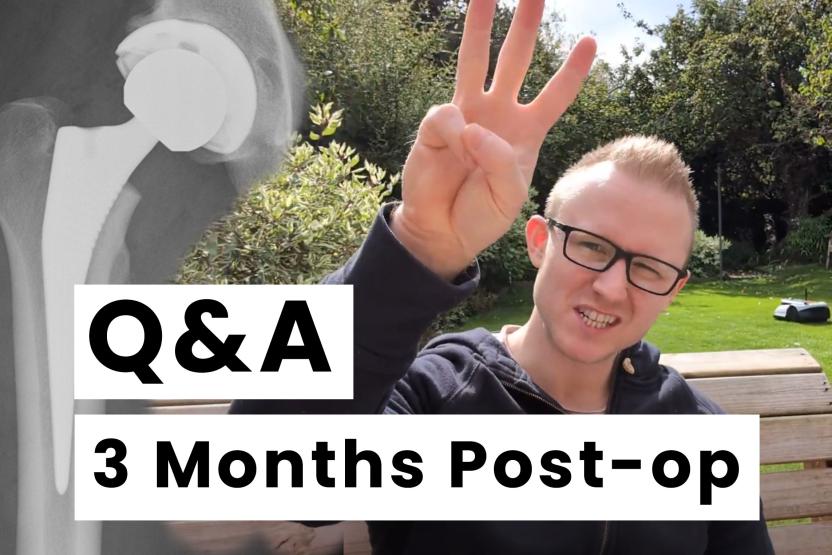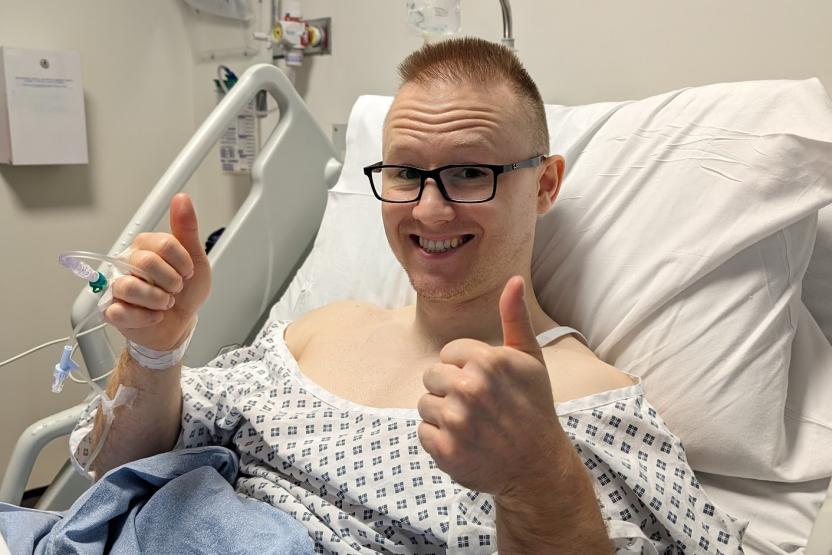Three months after my total hip replacement, I'm not just walking – I'm powerlifting, pain-free, and feeling stronger than pre-surgery in some areas. From unexpected setbacks to surprising triumphs, my recovery journey is proof that with the right mindset and strategy, you can defy expectations and redefine what's possible.
Curious how I did it? Let me share every lesson, challenge, and breakthrough I've experienced along the way. Full Q&A video:
Read my Full recovery diary here.
Hello, everyone! It’s mid-September, which marks exactly three months since I had a total hip replacement at the age of 35 (I’m now 36).
I had the surgery on my right side using the posterior approach here in the UK. I’ve compiled a list of questions that friends and family have asked me about my recovery, as well as some that I wanted to know myself when I reached this milestone. Here are all the details of my recovery journey so far.
Q&A: Three Months Post-Total Hip Replacement
1. How is your hip feeling at the three-month mark?
It’s feeling pretty good. I don’t really notice it in my day-to-day activities anymore. I’m following my usual routine and my sleep habits are back to normal. The only limitation is that I can't lift as heavy in the gym as I used to. I’m still lifting fairly heavy weights – around 120–130 kg on squats and deadlifts, while my bench press remains the same as before the surgery.
2. What exercises have you been able to resume and at what weight?
I’m doing everything I’d normally do in the gym, but with less weight on squats and deadlifts. Currently, I’m doing Romanian deadlifts, where the barbell doesn't touch the floor. Next week, I plan to progress to full deadlifts. My surgeon advised waiting three months before doing low-bar squats, where the bar is positioned lower on the back and involves more forward lean. However, other types of squats, such as high-bar, front squats, or safety bar squats, are fine. I'm also incorporating accessory movements to strengthen the glutes and surrounding muscles, along with stretches and balance work to improve overall stability.
3. Have there been any unexpected challenges or surprises during your recovery?
The biggest surprise has been how quickly I’ve recovered. I went into surgery in strong physical condition, and my consistent gym routine has greatly supported my rehabilitation. Maintaining a positive, growth-oriented mindset has also been invaluable. One unexpected challenge was a groin strain around the two-week mark, which took about a week to resolve. This was likely due to overuse, as the groin muscles are engaged more than we realise after surgery. I expected to experience sharp pain from the incision site, but I didn’t. Instead, it felt more like muscle soreness, similar to what you might feel after a hard workout.
4. How has your range of motion improved since the surgery?
The first month was mainly focused on regaining my range of motion. After that, it was all about progress. I haven’t had any significant range-of-motion issues since then. I still feel some tightness in my glute when I do certain stretches, but it’s manageable. Simple tasks like putting on socks were tricky for the first six weeks because I was careful to avoid any movements that might cause dislocation, but now, I’m almost back to normal. I’ve been stretching regularly and doing strength exercises that work through the range of motion, which has greatly helped my progress.
5. How do you manage any residual pain or discomfort, if any?
The main discomfort I experienced was groin pain around two weeks after surgery. This pain felt like muscle strain from overuse, not a sharp injury. I adjusted my walking technique to minimise strain, focusing on keeping my knees together and avoiding wide steps. This adjustment helped me recover while still allowing me to stay mobile around the house. If you're in a similar position, avoid letting your knee rotate inward, as this is how the hip can dislocate after a posterior hip replacement.
6. What advice would you give to others at the three-month mark post-surgery?
Everyone’s recovery journey is different, but generally, at three months, people fall into one of two camps: those still recovering and feeling frustrated, and those progressing quickly. It’s important to strike a balance between pushing yourself and giving your body the time it needs. Don’t rush – progress as fast as your body allows.
For example, I use a concept from powerlifting called the Rate of Perceived Exertion (RPE). I aim to train at an RPE of 7, which means I could do three more reps before reaching my limit. This approach has kept me progressing without overdoing it. It's essential not to push too hard too soon, as it could lead to setbacks like dislocation or injury.
7. How has your mental state and mindset evolved during these three months?
I approached this whole experience with a positive mindset. I looked forward to the benefits of the surgery and found the process quite enjoyable. Documenting the journey made it feel like a bit of a game, which added an element of fun. For me, having this kind of mindset helped me avoid stress and anxiety about the surgery, making the whole process more enjoyable. I’ve found that focusing on the positives, rather than fearing what could go wrong, has made a big difference in my recovery.
8. How has your diet contributed to your recovery?
Diet is one of many factors that contribute to recovery. I’ve been mindful of my nutrition, ensuring I get enough sleep, and sticking to my rehab and prehab exercises. I’ve supplemented with creatine and collagen (type 1 and type 2), particularly the forms approved for athletes, but I think these made a small difference – maybe 1–2%. Overall, it’s about doing lots of little things right. For instance, I’ve focused on staying hydrated and avoiding alcohol, especially in the first six weeks post-surgery, as alcohol can negatively affect recovery by disrupting sleep and increasing inflammation.
9. Are there any exercises or movements that you are still avoiding?
With a posterior approach, certain movements that risk dislocation are still off-limits. For example, movements where the knee internally rotates and brings the hip into a risky position are to be avoided. I’m particularly cautious with exercises like deep squats where the knee might bend inward. However, my surgeon is less concerned with movements where my knees are pointing outward. Other than that, I’m doing most exercises that I did before the surgery.
10. What feedback did you receive from the physiotherapist?
At my last appointment, the physiotherapist said I was a "model recovery" case and didn't need any more physiotherapy sessions unless I felt I needed them. This was great for my confidence, as it meant I’d been doing things right. They encouraged me to keep up with my current routine and to continue strengthening exercises under the guidance of my coach.
11. How has surgery impacted your daily life and routines?
The impact on my daily life has been minimal. I quickly returned to most of my regular activities and even saw improvements in some areas. For example, I’m no longer feeling pain when standing for long periods or after a heavy gym session, which used to be a problem before surgery. I’m also sleeping better now, without being woken up by discomfort.
12. What equipment or tools have been most useful in your rehabilitation?
Several pieces of equipment have been incredibly useful:
- Stepper Bench: This was essential for box squats, allowing me to control the depth of my squats safely.
- Pole (for Balance): I used a pole at home (my wife competes in pole dancing, so we have one at home) to assist with squats and balance exercises. It was invaluable, especially in the early stages of recovery.
- Resistance Bands: Great for building strength in the surrounding muscles without placing too much strain on the hip.
- Balance Ball: Helpful from week six onwards to improve balance and core strength.
- Dumbbells: Progressed from bodyweight exercises to light weights at home.
13. What goals are you setting for the next three months?
I’d like to increase my squat above 140 kg, without using the safety bar. I’d also like to compete in the British Bench Press Championships next year. My bench press hasn't regressed at all – in fact, I recently hit a personal best for reps. My focus is on gradual and safe progress.
14. How does your progress compare with your expectations when you first had the surgery?
I expected a slower recovery and had mentally cleared three months to give myself plenty of time. In reality, my recovery has been much faster. I was back at work after just two days off, which allowed me to get back to normal life and continue building my business. I had prepared for a much longer downtime, so this was a pleasant surprise.
15. How long did it take to feel stable and confident on your feet again?
I started walking with crutches immediately after surgery. Within a day or two, I felt comfortable enough to switch to one crutch while making breakfast, and by the end of the first week, I was down to no crutches. I had some groin pain after about two weeks, but once that resolved, I felt confident walking normally. By three to four weeks, I was power-walking around town and felt amazed by how stable I felt.
16. Have you experienced any setbacks?
The main setback was the groin strain around two weeks after surgery, likely due to overuse and not being careful enough with certain movements. It took about a week to recover from that, but otherwise, my recovery has been smooth.
17. How has your overall fitness level changed since surgery?
My fitness levels have remained quite high. I haven’t lost any muscle mass, and I feel just as strong as before the surgery. This is partly because I’ve stayed consistent with my rehab exercises and have applied principles from my powerlifting training to ensure I didn’t overdo it or under-train. I saw a study that suggested that trained athletes who stop completely may take about a week to regain two weeks' worth of lost fitness. I’ve managed to maintain most of my strength by staying active.
18. What has been the most helpful advice you received from medical professionals?
The best advice was to find a balance between being active and not overdoing it. It’s important to challenge yourself, but also to avoid pushing so hard that you risk injury. Regular check-ins with my surgeon and physiotherapist provided guidance on the pace I should aim for, ensuring I didn’t progress too quickly or too slowly.
19. What role did goal setting play in your recovery journey?
Setting goals was crucial. It gave me something to aim for and kept me motivated. By setting manageable goals, I was able to celebrate small wins daily, which was really encouraging. Treating recovery like a game, where every day can be a new personal best, helped keep my mindset positive.
20. What role has technology or apps played in your recovery?
I’ve used a WHOOP wristband to monitor my sleep and recovery. This helped me stay accountable and optimise my rest. I also use apps to record my weights and track my progress, keeping myself on target with my goals.
21. What are the most common questions people ask you about your recovery?
People often ask how I’m doing and whether I’m feeling okay. It’s nice to know people care and are interested in my recovery. Some ask more specific questions, like how I’m managing pain or how I’ve adjusted my routine, which I’ve also tried to answer on my blog.
22. What advice would you give to someone worried about the pain or difficulty of recovery?
Pain during recovery can happen, but in my experience, it wasn’t as bad as I expected. Keeping a positive mindset and being well-informed can make a huge difference. Try not to dwell on the possibility of pain, as confirmation bias can make it feel worse. Focus on the positives and stay optimistic about your progress.
23. How has the recovery process impacted your work or professional life?
I was able to get back to work quickly, which was a huge relief. I enjoy my work, and staying busy helped me avoid overthinking the recovery process. Because I run a business, being able to return to work sooner allowed me to keep things moving forward, which was beneficial for my mental state and motivation.
24. What would you do differently if you could go back to the start of your recovery?
I would have been more mindful of the risk of groin strain and avoided certain movements early on. For example, when I first went crutch-free, I probably overdid it with movements that involved wide steps or pivoting, which likely led to the strain. In hindsight, I’d have taken it easier with such movements for the first three weeks.
25. Have you experienced any numbness, stiffness, or lingering effects around the incision site?
Yes, I have some numbness around the incision site – there’s a strip about an inch below the incision that feels numb when I press on it, but it’s only on the skin surface. I also learned the importance of massaging the incision site to prevent adhesions. I started massaging the area with moisturiser after about six weeks, which helped loosen any adhesions forming beneath the skin.
26. Are there any misconceptions about hip replacement recovery that you'd like to address?
A common misconception is that a posterior approach leads to a more challenging recovery than an anterior one. While it's true that certain movements might be safer after an anterior approach, my recovery has been fast despite the posterior method. The most important factor is having a skilled surgeon with a good track record.
27. What do you wish you had known before going into the surgery?
I wish I had seen more examples of people like me – active and into sports – sharing their recovery journeys. This lack of relatable information is one of the reasons I wanted to create content like this blog and videos. Knowing how quickly others recovered would have helped set more realistic expectations.
28. What role has hydration played in your recovery, and have you adjusted your intake?
Staying hydrated has been crucial. I’ve been trying to drink more water and have significantly cut down on alcohol, particularly in the first six weeks post-surgery. Alcohol is detrimental to recovery as it can impact sleep, increase inflammation, and slow healing, so I’ve limited it as much as possible.
29. What are the unexpected benefits or positives from the surgery?
Some unexpected benefits include no longer feeling pain while standing for long periods or after heavy training sessions, which was an issue before surgery. Additionally, my technique in exercises like squats and deadlifts feels more balanced and stable, as I’m no longer compensating for hip pain.
30. How have you balanced rest and activity to optimise recovery?
I train three days a week, with rest days in between, to allow for recovery. I also ensure I get good sleep and focus on manageable exertion levels (RPE of 7). This approach balances pushing my body without overdoing it, helping me make steady progress without setbacks.
31. How have you handled the psychological aspects of recovery, such as frustration and impatience?
By setting my expectations low, I avoided frustration or impatience. I mentally prepared for a slower recovery than I experienced, so I felt I was progressing well. If you set the bar low, you are more likely to exceed your expectations, which keeps you motivated.
32. How did you transition from hospital to home recovery?
The transition was quite smooth. I stayed in the hospital for one night after surgery and was discharged the next day. I immediately started moving around and doing light activities at home, like making breakfast, which helped me feel more confident and reassured that I could handle the recovery.
Final Thoughts
If you’re about to have a hip replacement, good luck! Remember that while we can’t control every event in our lives, we can control how we respond to them. Try to enjoy the journey – a positive mindset can make all the difference.
You can also read my full recovery diary here.
If you have any questions, feel free to reach out!
Recommended Coaching
If you’re after the same evidence-driven programming that helped me progress safely from the operating table back to 200 kg+ lifts, I can’t recommend my coach, Luke Rogers, highly enough. Luke is a coach for the Great Britain junior powerlifting team, a former British Champion, and Head Coach at MSC Performance in Birmingham. His focus on technique, tempo, and load management has been crucial to my recovery. Whether you’re coming back from surgery or simply want to push your strength further, I’d strongly suggest getting in touch. You can reach him on Instagram @luke_rogers_74, on Linkedin, or through the MSC Performance website.
For full disclosure, I don’t receive any kickback from these recommendations. I’m recommending Luke simply because I’ve used his services for years and trust him. It’s a personal recommendation, and I feel I owe him a thank you by mentioning him at the end of this article.
DISCLAIMER: I am not a medical or nutrition professional and am not qualified to give medical or sports advice. The information provided in this article is for informational purposes only and is provided "as-is". It should not be interpreted as medical, nutrition, or sports advice. Please make sure you do your own research and seek the advice of qualified professionals to guide your actions.







